【python】英语单词文本处理
【python】英语单词文本处理

前言
缘起自懒得考小孩儿单词,最终效果如图:
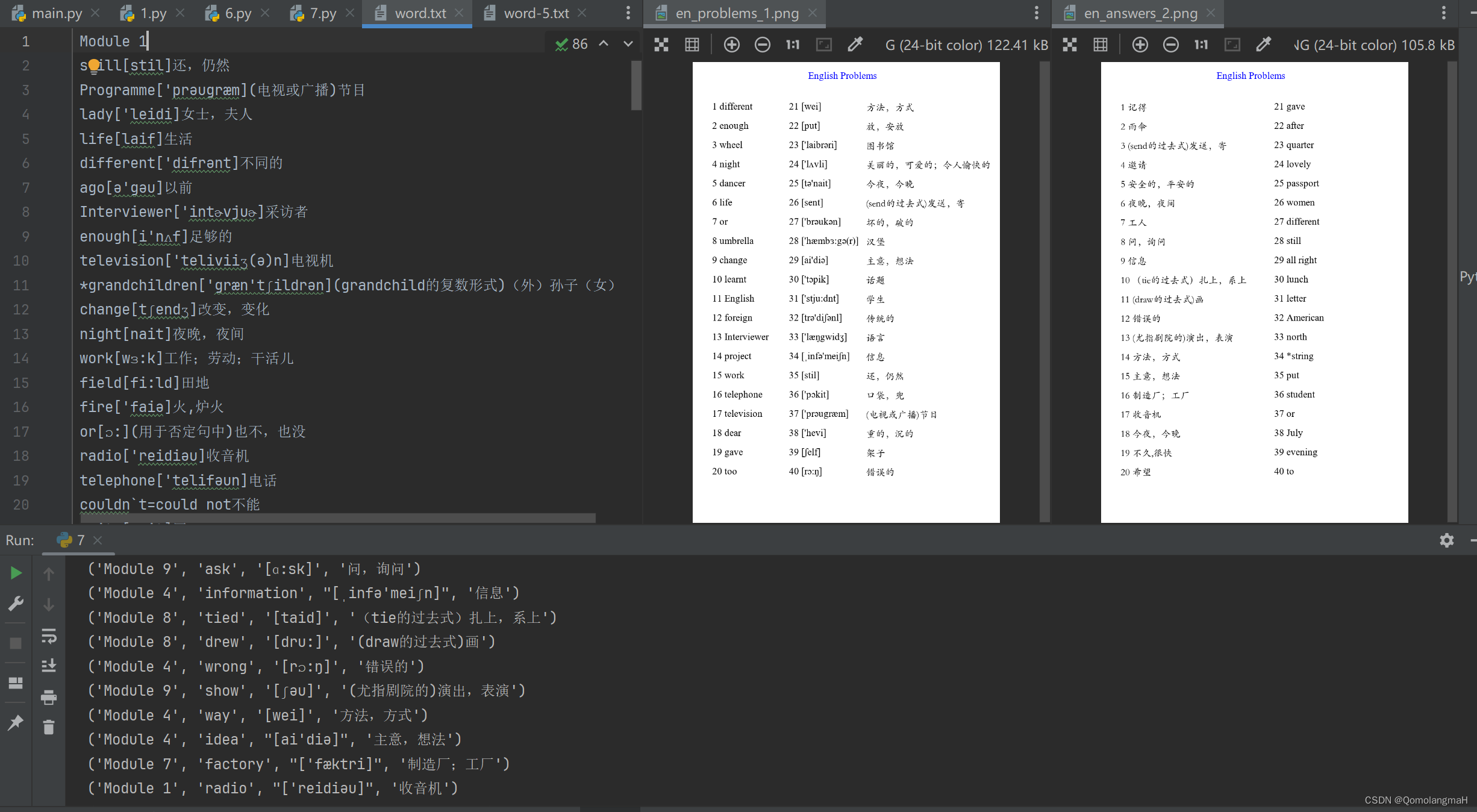
本文记录了英语单词文本处理过程,生成“试卷”
PS:单词docx文件来源于百度文库高校版(单词txt文本附文末)
一、环境
实验所需的库
import re
import numpy as np
from PIL import Image, ImageDraw, ImageFont终端指令
conda create -n DL python==3.11conda activate DLconda install numpy pillow或
pip install numpy pillow二、实现过程
大过年的,暂不对代码进行详细介绍,其进化过程如下:
Version 1 起源
import re
with open('./word.txt', 'r', encoding='utf-8') as file:
for line in file:
if re.match(r'^[A-Za-z*]', line): # 使用正则表达式匹配以英文字母开头的行
if 'Module' in line:
continue
if '[' not in line: # 如果行中没有 [
print("无法解析的行:", line) # 直接输出行的内容
continue
word, pro_chinese = line.strip().split('[')
pronunciation, meaning = pro_chinese.strip().split(']')
pronunciation = '[' + pronunciation + ']' # 将括号加回去
meaning = meaning.rstrip() # 去掉末尾的换行符
print("单词:", word)
print("音标:", pronunciation)
print("中文:", meaning)
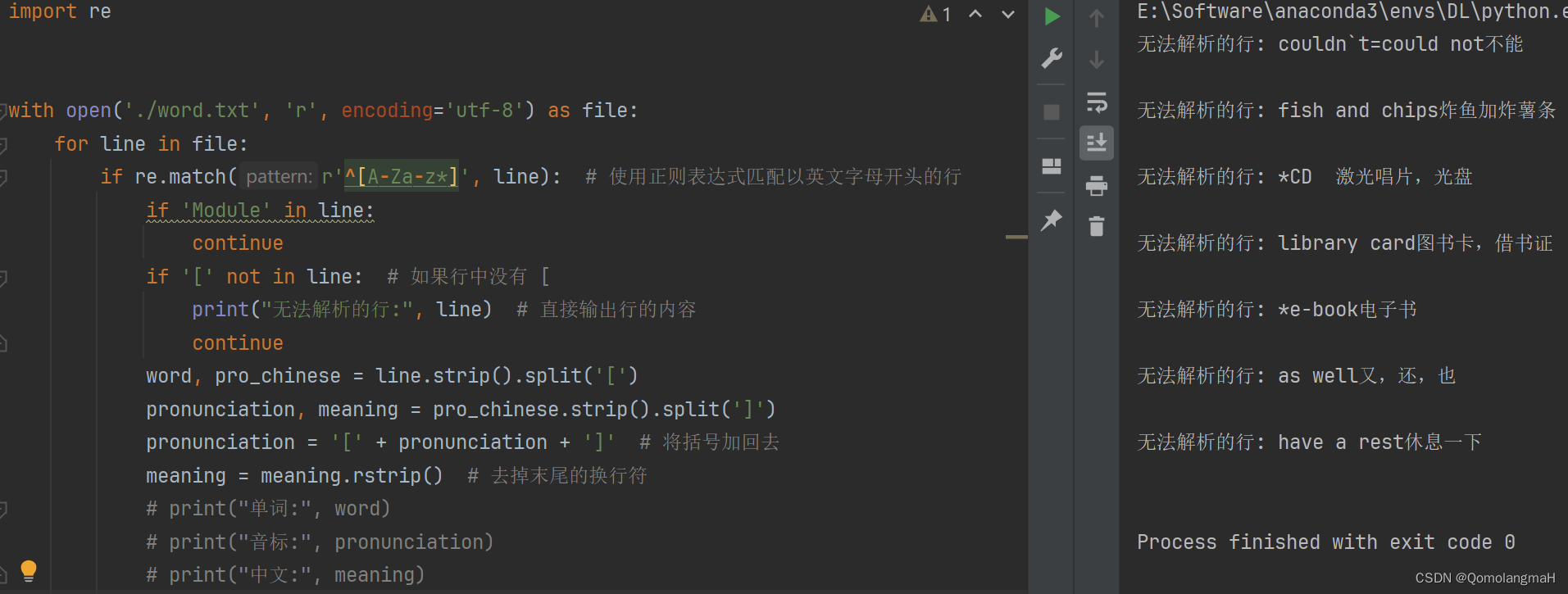
Version 2 list
存储为列表
import re
words, pronunciations, meanings, modules = [], [], [], []
with open('./word.txt', 'r', encoding='utf-8') as file:
current_module = ""
for line in file:
if re.match(r'^[A-Za-z*]', line): # 使用正则表达式匹配以英文字母开头的行
if 'Module' in line:
current_module = line.strip()
# print(current_module)
continue
if '[' not in line: # 如果行中没有 [
# print("无法解析的行:", line) # 直接输出行的内容
continue
word, pro_chinese = line.strip().split('[')
pronunciation, meaning = pro_chinese.strip().split(']')
pronunciation = '[' + pronunciation + ']' # 将括号加回去
meaning = meaning.rstrip() # 去掉末尾的换行符
# print("单词:", word)
# print("音标:", pronunciation)
# print("中文:", meaning)
words.append(word)
pronunciations.append(pronunciation)
meanings.append(meaning)
modules.append(current_module)
for i in range(len(words)):
print(modules[i], words[i], pronunciations[i], meanings[i])
Version 3 array
存储为array数组
import re
import numpy as np
words, pronunciations, meanings = np.array([]), np.array([]), np.array([])
with open('./word.txt', 'r', encoding='utf-8') as file:
current_module = ""
for line in file:
if re.match(r'^[A-Za-z*]', line): # 使用正则表达式匹配以英文字母开头的行
if 'Module' in line:
current_module = line.strip()
print(current_module)
continue
if '[' not in line: # 如果行中没有 [
print("无法解析的行:", line) # 直接输出行的内容
continue
word, pro_chinese = line.strip().split('[')
pronunciation, meaning = pro_chinese.strip().split(']')
pronunciation = '[' + pronunciation + ']' # 将括号加回去
meaning = meaning.rstrip() # 去掉末尾的换行符
words = np.append(words, word)
pronunciations = np.append(pronunciations, pronunciation)
meanings = np.append(meanings, meaning)
for i in range(len(words)):
print("单词:", words[i])
print("音标:", pronunciations[i])
print("中文:", meanings[i])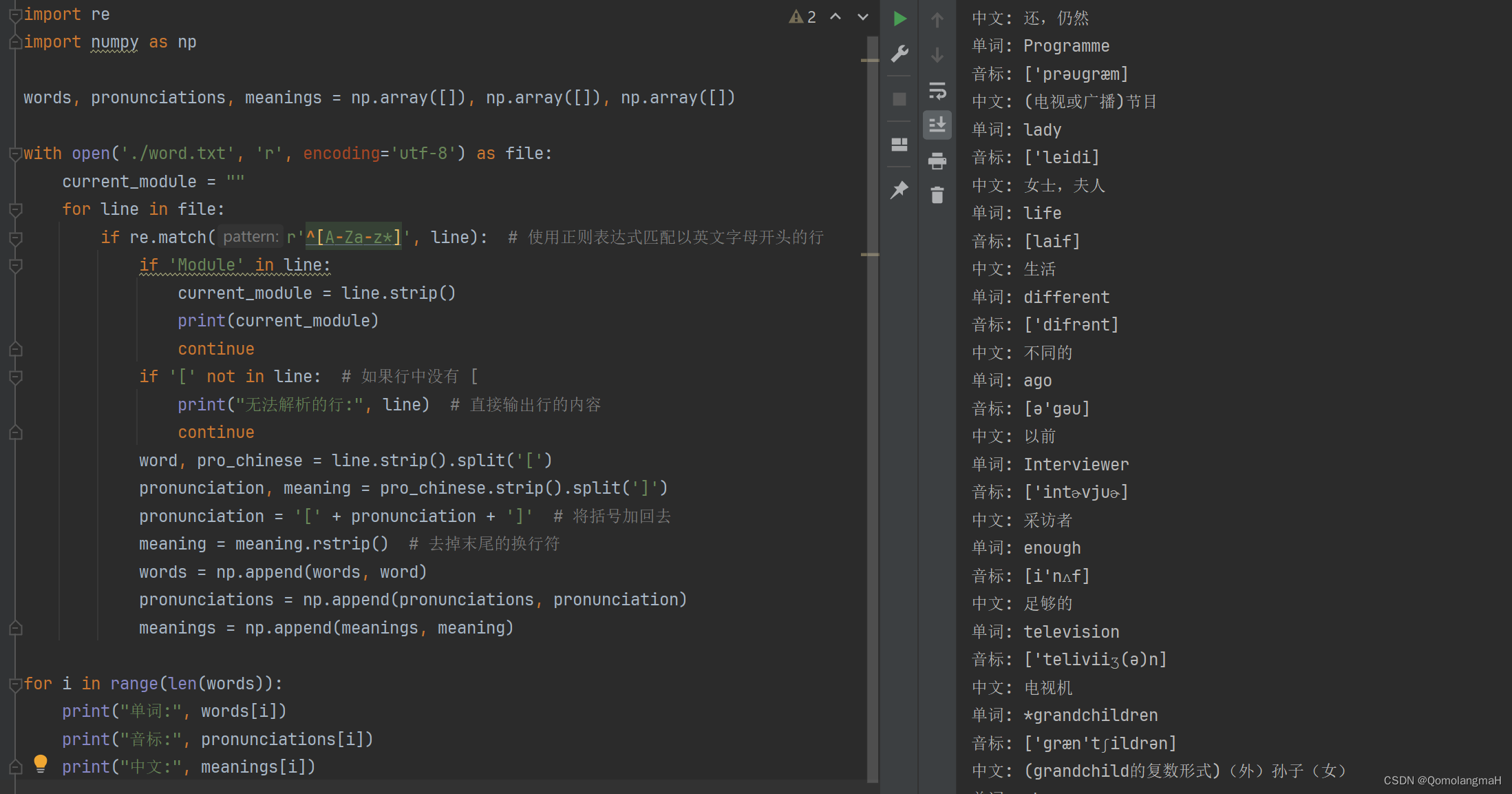
Version 4 结构化数组
进化为结构化数组
import re
import numpy as np
# 定义结构化数组的数据类型
dt = np.dtype([('word', 'U50'), ('pronunciation', 'U50'), ('meaning', 'U50')])
# 创建空的结构化数组
data = np.array([], dtype=dt)
with open('./word.txt', 'r', encoding='utf-8') as file:
for line in file:
if re.match(r'^[A-Za-z*]', line): # 使用正则表达式匹配以英文字母开头的行
if 'Module' in line:
continue
if '[' not in line: # 如果行中没有 [
# print("无法解析的行:", line) # 直接输出行的内容
continue
word, pro_chinese = line.strip().split('[')
pronunciation, meaning = pro_chinese.strip().split(']')
pronunciation = '[' + pronunciation + ']' # 将括号加回去
meaning = meaning.rstrip() # 去掉末尾的换行符
new_data = np.array([(word, pronunciation, meaning)], dtype=dt) # 创建包含当前单词数据的结构化数组
data = np.append(data, new_data) # 将当前单词数据添加到总的结构化数组中
for i in data:
print(i)
Version 5 区分单元且打乱顺序
区分单元且打乱顺序
import re
import numpy as np
# 定义结构化数组的数据类型
dt = np.dtype([('module', 'U50'), ('word', 'U50'), ('pronunciation', 'U50'), ('meaning', 'U50')])
# 创建空的结构化数组
data = np.array([], dtype=dt)
with open('./word.txt', 'r', encoding='utf-8') as file:
current_module = ""
for line in file:
if re.match(r'^[A-Za-z*]', line): # 使用正则表达式匹配以英文字母开头的行
if 'Module' in line:
current_module = line.strip()
# print(current_module)
continue
if '[' not in line: # 如果行中没有 [
# print("无法解析的行:", line) # 直接输出行的内容
continue
word, pro_chinese = line.strip().split('[')
pronunciation, meaning = pro_chinese.strip().split(']')
pronunciation = '[' + pronunciation + ']' # 将括号加回去
meaning = meaning.rstrip() # 去掉末尾的换行符
new_data = np.array([(current_module, word, pronunciation, meaning)], dtype=dt) # 创建包含当前单词数据的结构化数组
data = np.append(data, new_data) # 将当前单词数据添加到总的结构化数组中
np.random.shuffle(data)
# 打印打乱顺序后的数组
print(data[0]['word'])
print(len(data))
for d in data:
print(d)
for d in data:
if d['module'] == 'Module 1':
print(d)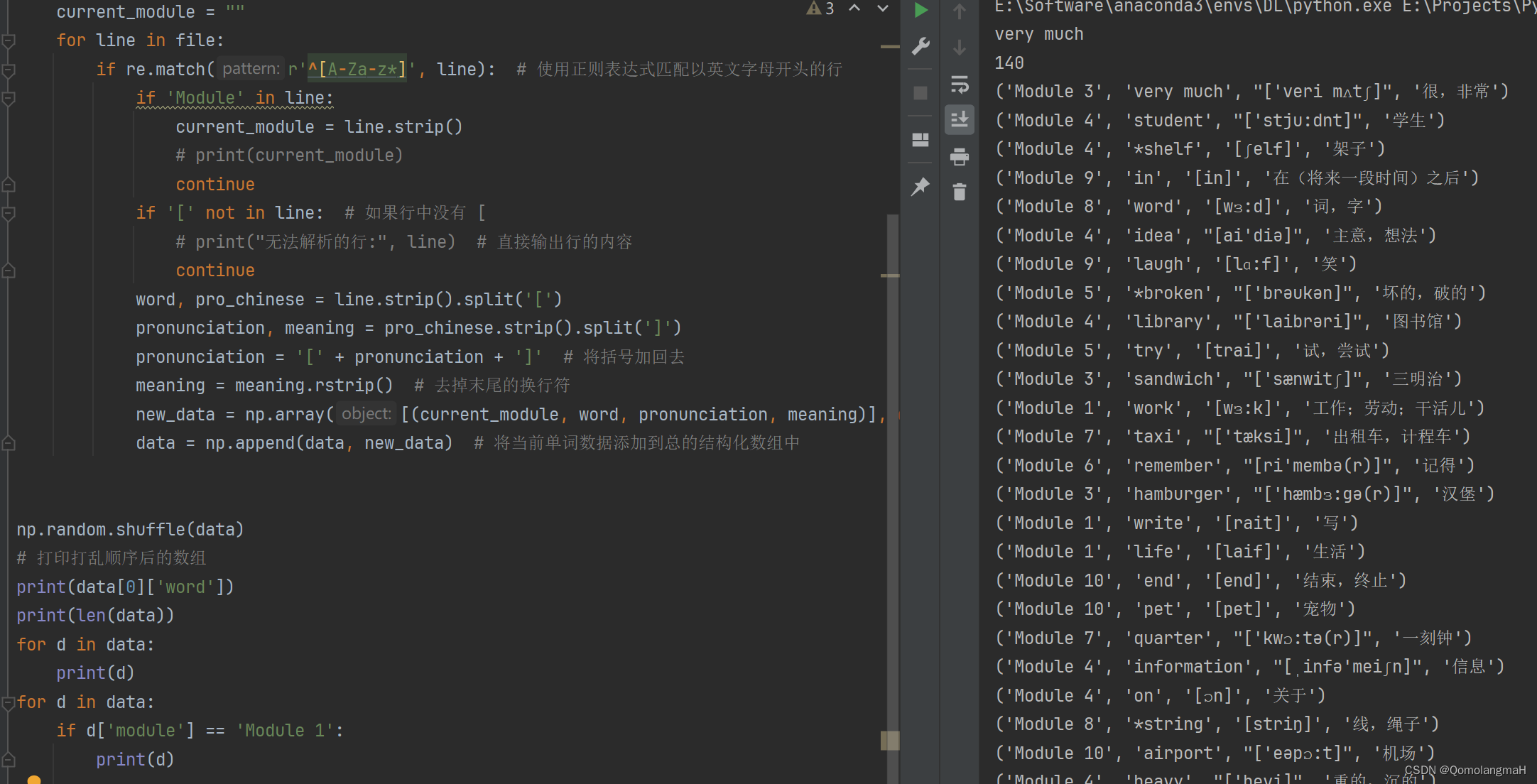
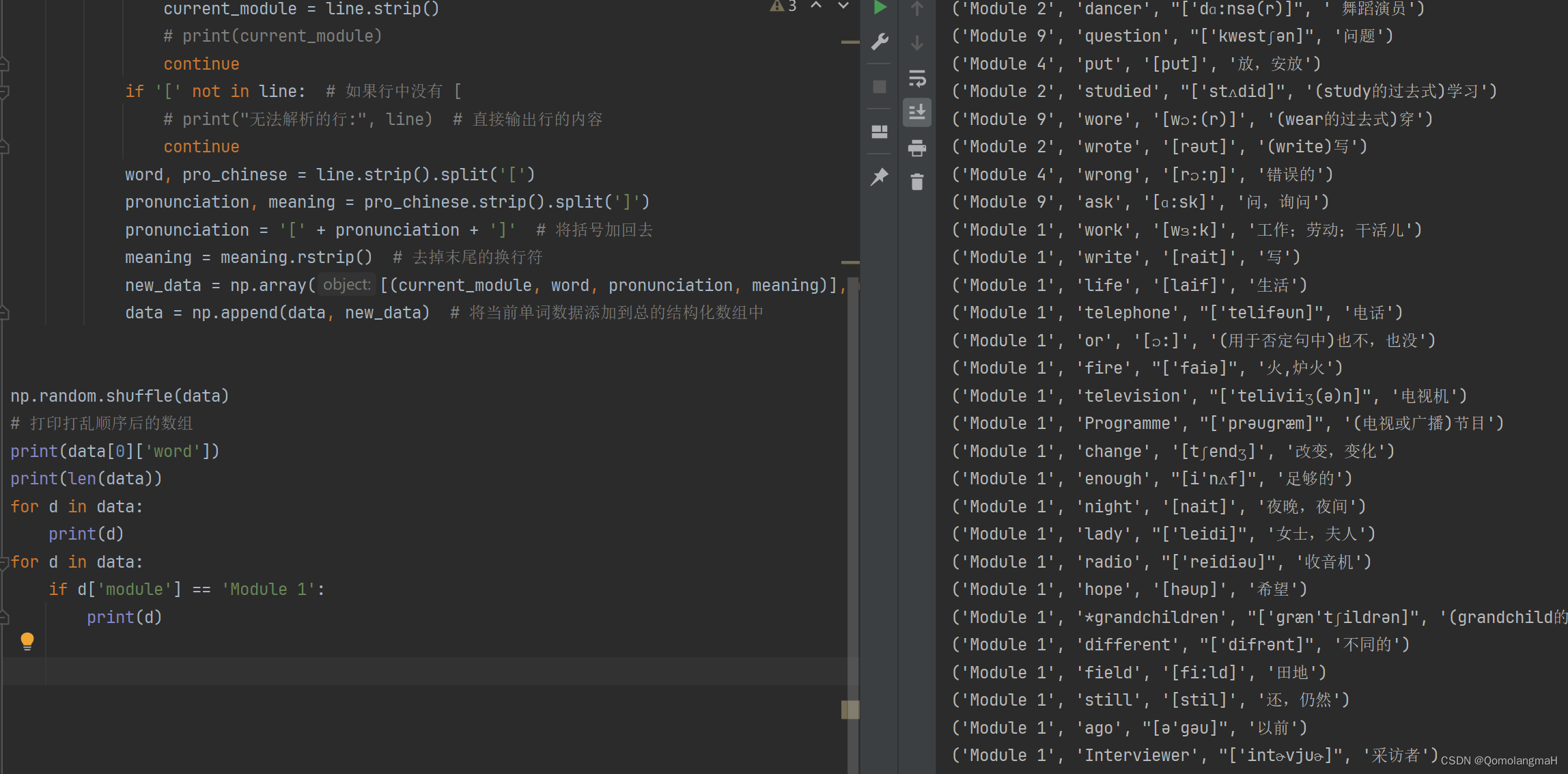
Version 6 可视化
可视化
import re
import numpy as np
from PIL import Image, ImageDraw, ImageFont
# 定义结构化数组的数据类型
dt = np.dtype([('module', 'U50'), ('word', 'U50'), ('pronunciation', 'U50'), ('meaning', 'U50')])
# 创建空的结构化数组
data = np.array([], dtype=dt)
with open('./word.txt', 'r', encoding='utf-8') as file:
current_module = ""
for line in file:
if re.match(r'^[A-Za-z*]', line): # 使用正则表达式匹配以英文字母开头的行
if 'Module' in line:
current_module = line.strip()
print(current_module)
continue
if '[' not in line: # 如果行中没有 [
print("无法解析的行:", line) # 直接输出行的内容
continue
word, pro_chinese = line.strip().split('[')
pronunciation, meaning = pro_chinese.strip().split(']')
pronunciation = '[' + pronunciation + ']' # 将括号加回去
meaning = meaning.rstrip() # 去掉末尾的换行符
new_data = np.array([(current_module, word, pronunciation, meaning)], dtype=dt) # 创建包含当前单词数据的结构化数组
data = np.append(data, new_data) # 将当前单词数据添加到总的结构化数组中
# 打印数组
print(data[0]['word'])
print(len(data))
for d in data:
if d['module'] == 'Module 1':
print(d)
np.random.shuffle(data)
# 打印打乱顺序后的数组
print(data)
# dt = np.dtype([('module', 'U50'), ('word', 'U50'), ('pronunciation', 'U50'), ('meaning', 'U50')])
problem_image = Image.new('RGB', (800, 1200), color='white')
draw = ImageDraw.Draw(problem_image)
# font = ImageFont.truetype("arial.ttf", 25)
c_font = ImageFont.truetype("STKAITI.TTF", 25) # 华文楷体
e_font = ImageFont.truetype("times.ttf", 25) # times new Roman
text_y = 100
draw.text((300, 20), 'English Problems', fill='blue', font=e_font)
for i in range(20):
draw.text((50, text_y), str(i+1)+' '+data[i]['word'], fill='black', font=e_font)
draw.text((350, text_y), str(i + 21) + ' ' + data[i+20]['meaning'], fill='black', font=c_font)
text_y += 50
problem_image.save('en_problems_3.png')
# Generate a combined image of the answers
answer_image = Image.new('RGB', (800, 1200), color='white')
draw = ImageDraw.Draw(answer_image)
text_y = 100
draw.text((300, 20), 'English Problems', fill='blue', font=e_font)
for i in range(20):
draw.text((50, text_y), str(i+1)+' '+data[i]['meaning'], fill='black', font=c_font)
draw.text((450, text_y), str(i + 21) + ' ' + data[i+20]['word'], fill='black', font=e_font)
text_y += 50
answer_image.save('en_answers_3.png')问题:左侧前20英译汉,右侧汉译英:
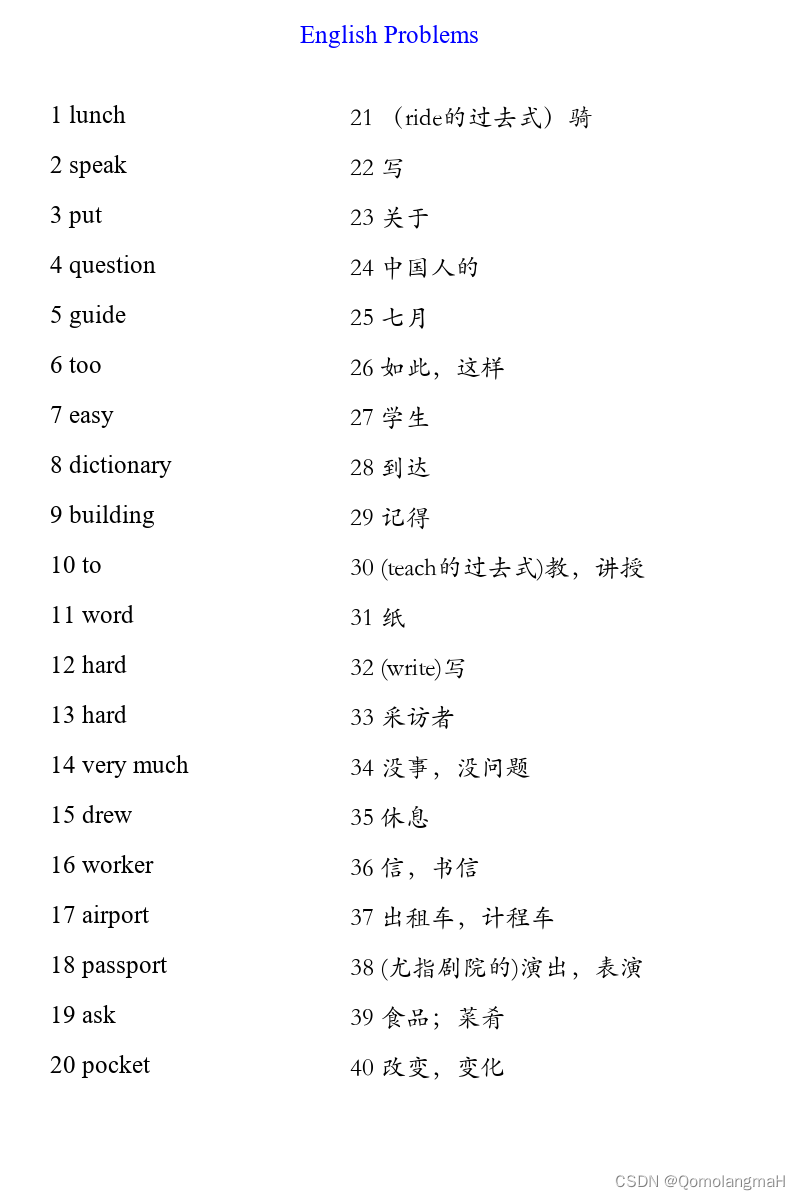
答案:
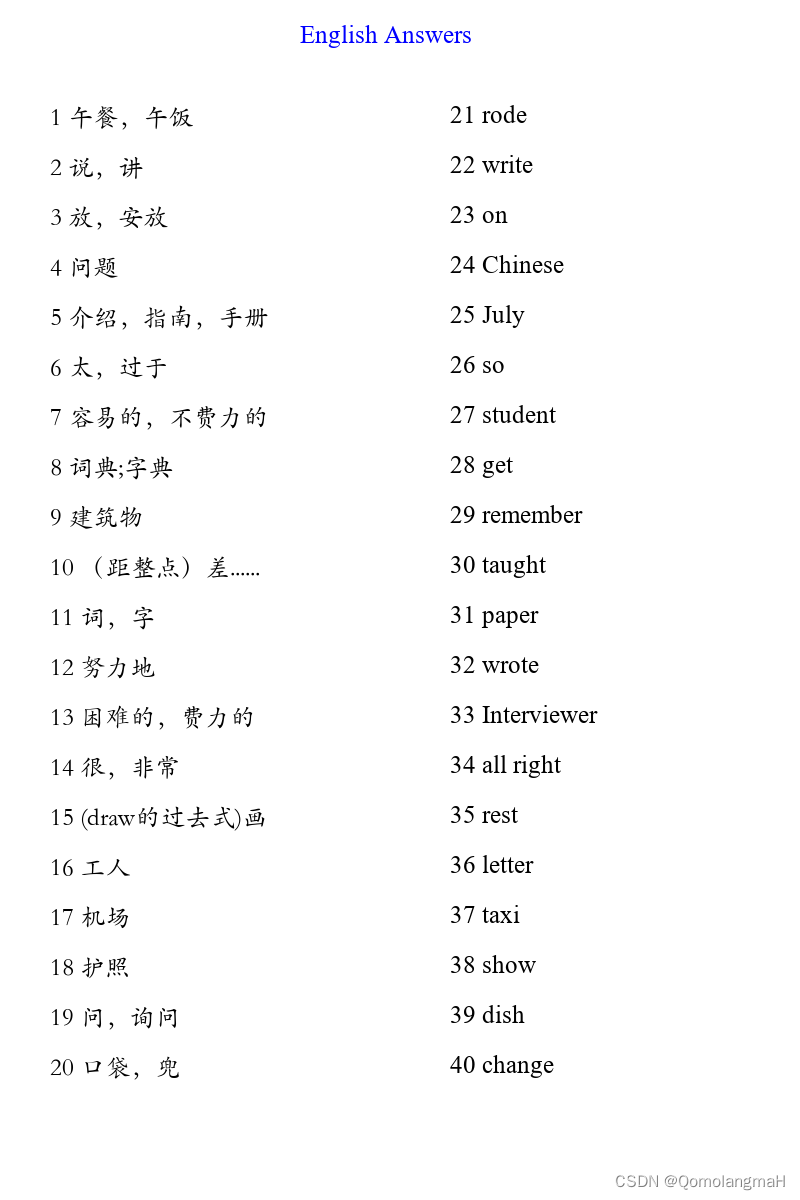
三、txt文件
外研社小学英语五年级下册(三年级起点)单词表(带音标):
Module 1 still[stil]还,仍然 Programme’prəugræm节目 lady['leidi]女士,夫人 life[laif]生活 different['difrənt]不同的 ago[ə’gəu]以前 Interviewer['intɚvjuɚ]采访者 enough[i’nʌf]足够的 television['teliviiʒ(ə)n]电视机 *grandchildren’græn’tʃildrən(外)孙子(女) change[tʃendʒ]改变,变化 night[nait]夜晚,夜间 work[wɜ:k]工作;劳动;干活儿 field[fi:ld]田地 fire['faiə]火,炉火 orɔ:也不,也没 radio['reidiəu]收音机 telephone['telifəun]电话 couldn`t=could not不能 write[rait]写 hope[həup]希望
Module 2 learnt[lɜ:nt](learn的过去式)学习 taughttɔ:t教,讲授 language['læŋgwidʒ]语言 wroterəut写 dancer['dɑ:nsə®] 舞蹈演员 foreign['fɔrən]外国的 studied’stʌdid学习 hard[hɑ:d]努力地
Module 3 hamburger['hæmbɜ:gə®]汉堡 English['iŋgliʃ]英国(式)的 breakfast['brekfəst]早餐,早饭 lunch[lʌntʃ]午餐,午饭 sandwich['sænwitʃ]三明治 fish and chips炸鱼加炸薯条 traditional[trə’diʃənl]传统的 dish[diʃ]食品;菜肴 very much['veri mʌtʃ]很,非常 gave[geiv](give的过去式)给 tonight[tə’nait]今夜,今晚
Module 4 library['laibrəri]图书馆 student['stju:dnt]学生 sentsent发送,寄 *CD 激光唱片,光盘 idea[ai’diə]主意,想法 put[put]放,安放 *shelf[ʃelf]架子 heavy['hevi]重的,沉的 dictionary['dikʃənri]词典;字典 card[kɑ:d]卡片 library card图书卡,借书证 ask[ɑ:sk]邀请 wrong[rɔ:ŋ]错误的 dear[diə®]哎呀 information[ˌinfə’meiʃn]信息 *e-book电子书 project['prɔdʒekt]项目 guide[gaid]介绍,指南,手册 film[film]电影 as well又,还,也 way[wei]方法,方式 on[ɔn]关于 *topic['tɔpik]话题
Module 5 light[lait]轻的 hard[hɑ:d]困难的,费力的 *broken['brəukən]坏的,破的 department store[di’pɑ:tmənt stɔ:]百货商店 pocket['pɔkit]口袋,兜 umbrella[ʌm’brelə]雨伞 sales assistant[seilz ə’sistənt]售货员,营业员 wheel[wi:l]轮子 easy['i:zi]容易的,不费力的 take[teik]选择要,选择购买 too[tu:]太,过于 try[trai]试,尝试 lovely['lʌvli]美丽的,可爱的;令人愉快的
Module 6 moon[mu:n]月亮,月球 get[ɡet]到达 west[west]西,西部,西方;向西方 parent['peərənt]母亲;父亲;家长 stay[stei]停留 July[dʒu’lai]七月 south[sauθ]南,南部,南方;向南方 remember[ri’membə®]记得 June[dʒu:n]六月 east[i:st]东,东部,东方;向东方 best[best]最好的 north[nɔ:θ]北,北部,北方;向北方 rest[rest]休息 have a rest休息一下 rode[rəud](ride的过去式)骑
Module 7 evening['i:vniŋ]傍晚,晚上 late[leit]近日暮的;近深夜的;时间不早的 worker['wɜ:kə®]工人 factory['fæktri]制造厂;工厂 early['ɜ:li]早的 taxi['tæksi]出租车,计程车 quarter['kwɔ:tə®]一刻钟 to[tu,tə](距整点)差… worry['wʌri]焦虑,担心
Module 8 paper['peipə®]纸 Chinese[ˌtʃai’ni:z]中国人的 so[səʊ]如此,这样 word[wɜ:d]词,字 drewdru:画 cutkʌt剪,切,割 piece[pi:s]张,片,块 paint[peint](用颜料)绘画,着色 putput放,安放 stick[stik]小木棍,小木条 tied[taid](tie的过去式)扎上,系上 *string[striŋ]线,绳子
Module 9 laugh[lɑ:f]笑 worewɔ:®穿 letter['letə®]信,书信 theatre['θiətə]剧院 women’wimin女性,妇女 actor['æktə®]演员 toldtəuld口述,讲(故事等) joke[dʒəuk]笑话 after['ɑ:ftə®]在……以后 showʃəu演出,表演 restaurant['restrɔnt]饭店,餐馆 readri:d读 at all[æt ɔ:l]一点都 in[in]在(将来一段时间)之后 another[ə’nʌðə®]另一个 history['histri]历史 ask[ɑ:sk]问,询问 question['kwestʃən]问题 forget[fə’get]忘,忘记 bring[briŋ]带来,拿来 soon[su:n]不久,很快
Module 10 when[wen]在什么时候 end[end]结束,终止 nervous['nɜ:vəs]紧张的,情绪不安的 all right[ɔ:l rait]没事,没问题 airport['eəpɔ:t]机场 ticket['tikit]票 passport['pɑ:spɔ:t]护照 safe[seif]安全的,平安的 pet[pet]宠物 speak[spi:k]说,讲 building['bildiŋ]建筑物 American[ə’merikən]美国的;美国人的;美国人 find out[faind aut]发现,弄清 more[mɔ:®]更多的(量),较多的(量)











